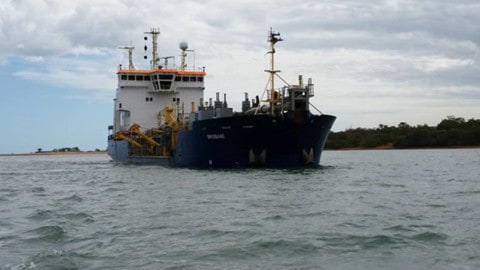Laurence Dinham, Machinery Group Lead at ExxonMobil, leads a group of machinery engineers onsite at the Mobil Altona refinery. The Altona refinery is amongst the safest and most reliable refineries, not just in Australia, but in ExxonMobil’s portfolio of refineries worldwide. In this article, we discuss pump reliability and the factors that contribute to achieving improvement.
Mobil’s Altona refinery currently has 580 pumps across the site. This is enough to keep Laurence and his trio of pump engineers busy monitoring, troubleshooting, optimising and upgrading, as well as procuring and installing pumps when required.
“Most of my time is spent troubleshooting and identifying opportunities for improvement, working closely with the process engineers, operators and technicians. We’ve upgraded a number of motors in the last few months, and also got some new pumps onsite. In the environment of changing feed stocks and export products, there is always opportunities to improve flow rates and efficiency.
“Our entire refinery (including the pumps) operates flexibly, with continual changes that allow us to optimise production based on feedstock and desired finished products. We really don’t ever sit still. The goal posts are almost always moving,” said Mr Dinham.
Choosing the right pump
When choosing a new pump, the system and design must fit from a process perspective. Mr Dinham must first identify the desired flow rate and pressure, to ensure that hydraulically, the process conditions are met. Once this has been achieved, the design and materials used in the pump have to be taken into consideration.
“When choosing a pump, we have to be careful to select a material that is suitable for the chemical and environmental conditions in which it will be used,” said Mr Dinham.
Another design factor is the selection of appropriate seals, depending on aspects including the process stream and the risk of potential emissions.
“Reliability of the pump is a major consideration for us. Our goal is to maximise the safety and longevity of the pump while balancing the cost,” said Mr Dinham.
Throughout the process of pump design and selection, there are local and national standards to consider, as well as company design practices.
“All of our pumps must firstly adhere to the current American Petroleum Institute standards. We then have our own standards on top of those which add additional design requirements,” said Mr Dinham.
 Pump procurement
Pump procurement
Procurement of a new pump can take many months to a year, as everything that is to be changed on site must be carefully reviewed and documented. This is to ensure that the refinery continues to run safely, smoothly and efficiently, with safety always being the number one priority.
“When procuring, installing or making changes to an existing pump, there is a management of change procedure,” said Mr Dinham. “There are many different departments that must approve any change, so this involves a lot of teamwork. Ultimately, the viability of a change in terms of cost versus benefit will be the deciding factor in whether it is supported.”
Teamwork
“Optimisation and changes to the pumps at the Altona refinery involves a huge amount of collaboration,”said Mr Dinham.
“It really is a big team effort, and I am always bowled over with how important this is. I used to work at a large refinery in Texas. I remember walking through the gates and looking at this incredibly large and complicated plant, wondering how it could all possibly work so smoothly. Although smaller, it’s the same here at the Altona refinery, the secret is teamwork.
“Everybody has an area of responsibility and accountability. There are process engineers, chemical, instrument, electrical and piping engineers. We all get together when we’ve identified any opportunity for change or improvement. Everyone is focused on the same goal, keeping Altona refinery running safely, reliably and efficiently.
 Pump reliability
Pump reliability
Usually reliability and profitability go hand in hand, said Mr Dinham, but there is a point where investment gives a diminishing return on reliability. Getting the balance right in terms of the hardware and the maintenance activities is important.
“Pump reliability at the Altona refinery is now amongst the highest anywhere in world, as is our safety record. The high reliability has been achieved not by changing out all the pumps, but by increasing the focus on the way we operate and maintain the pumps.
“When I first started as a machinery engineer 25 years ago in the UK, we’d think it was good to have a pump run reliably for two or three years. I have since learned, that if we design it right, operate it right and maintain it right, a pump can run a great deal longer.
“Altona refinery now has an average run length of the pumps of around 14 years. How we have achieved this is by closely examining pump issues to understand the root cause not just looking for opportunities in hardware design, but also applying learnings in the way we operated or maintained the pumps.
“If we find a design opportunity, it can take months and years to modify and then see a return on reliability, but if we can find ways to improve the way we operate or maintain our pumps, those learnings can be applied very quickly and across the whole site. I don’t yet know what the ceiling is for high pump reliability, but I do know that month on month, we continue to see opportunities to improve the way we operate and maintain them.
“I have learned that the processes for achieving high reliability and safety are very similar. Treat every incident as avoidable, look for the learnings, and don’t just look for opportunities in hardware upgrades and technical innovation the biggest opportunity is more often in people and their behaviours.
The importance of Australian-made
Beginning his career in UK, and working with ExxonMobil in the US, Mr Dinham has seen and worked with an immense range of pumps and equipment. Most excitingly, Mr Dinham said he is impressed with the quality and degree of service that Australian pump manufacturers offer.
“I’m a strong supporter of Australian pumps. There are some excellent manufacturers out there, offering excellent service. For low cost opportunities, ExxonMobil has the ability to use a number of international brands. However, for more critical oil and gas pumps we usually use Australian, European or American brands that are well known to the company.
“This can be costly, but brands like United Pumps and Flowserve are excellent. We actually have a Kelly and Lewis pump on site that has been running smoothly for 30 years – it’s a brand I’ve never seen outside of Australia.
The future of pumps
The future of pumps, according to Mr Dinham, will see tighter emissions standards for seals, lower noise requirements, improved materials handling a wider range of fluids and temperatures, with an increasing need for instrumentation and monitoring to move more into predictive maintenance and away from costly planned maintenance activities with ever increasing reliability expectations. Each will challenge the way the industry designs and maintains pumps, as well as the way new manufacturing techniques allow suppliers to build pumps.
“Pumps being made in low cost countries while maintaining high reliability is a new opportunity for the industry. Moving to lower emissions and selection of mechanical seals and the associated instrumentation will be an increasing challenge for us in pump design.”

















